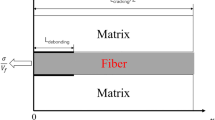Abstract
Two types of composite layer model were used to characterize the surface-limited microcrack damage: (i) a dynamic modulus model and (ii) a rule-of-mixtures model. Each model can be applied to either one or two microcracked surface layers for all physically meaningful values of the relative thickness of the layer(s) and all physically meaningful values of the microcrack damage severity states. The microcrack severity can be described in terms of known functions of microcrack size, number density and orientation. A second paper will deal with the details of applying the models to microcracks of a particular geometry, while a third paper deals with experimental tests of the models presented here.
Similar content being viewed by others
References
Y. Kim, W. J. Lee andE. D. Case, in “Metal and Ceramic Matrix Composites: Processing, Modeling and Mechanical Behavior”, edited by R. B. Bhagat, A. H. Clauer, P. Kumar and A. M. Ritter (Minerals, Metals and Materials Society, Warrendale, PA, 1990) pp. 479–86.
Idem, in Proceedings of 5th Technical Conference, June 12–14 1990, East Lansing, MI, American Society for Composites (Technonic Publishing Co, Lancaster PA 1990) pp. 871–881.
W. J. Lee andE. D. Case,Mater. Sci. Engng A119 (1989) 113.
Idem, J. Mater. Sci. 25 (1990) 5043.
B. Budiansky andR. J. O'connell,Int. J. Solids Struct. 12 (1976) 81.
A. Hoenig,ibid. 15 (1979) 137.
N. Laws andJ. R. Brockenbrough,ibid. 23 (1987) 1247.
D. P. H. Hasselman andJ. P. Singh,Amer. Ceram. Soc. Bull. 58 (1979) 856.
T. Yokobori andM. Ichikawa,J. Phys. Soc. Jpn. 19 (1964) 2341.
W. R. Delameter, G. Herrmann andD. M. Barnett, “Solid by a Rectangular Array of Cracks”,J. Appl. Mech, Trans. ASME 43 (1975) 74.
J. J. Mecholsky Jr, S. W. Freiman andR. W. Rice,J. Amer. Ceram. Soc. 60 (1977) 114.
H. P. Kirchner andE. D. Issacson,ibid. 65 (1982) 55.
H. P. Kirchner,ibid. 67 (1984) 127.
Idem, ibid. 67 (1984) 347.
T. J. Larchuk, J. C. Conway Jr andH. P. Kirchner,ibid. 68 (1985) 209.
J. D. B. Veldkamp, N. Hattu andG. deWith, “High Temperature Scratching of Some Brittle Materials”, in “Fracture Mechanics of Ceramics”, Vol. 5, edited by R. C. Bradt, A. G. Evans, D. P. H. Hasselman and F. F. Lange (Plenum, New York, 1983) pp. 121–144.
D. B. Marshall, in “Fracture in Ceramic Materials; Toughening Mechanisms, Machining Damage, Shock”, edited by A. G. Evans (Noyes, Park Ridge, New Jersey, 1984) pp. 190–220.
B. R. Lawn, A. G. Evans andD. B. Marshall,J. Amer. Ceram. Soc. 63 (1980) 574.
B. R. Lawn andM. V. Swain,J. Mater. Sci. 10 (1975) 113.
B. R. Lawn andD. B. Marshall,J. Amer. Ceram. Soc. 62 (1979) 347.
G. R. Anstis, P. Chantikul, B. R. Lawn andD. B. Marshall,ibid. 64 (1981) 533.
B. R. Lawn andE. R. Fuller,J. Mater. Sci. 10 (1975) 2016.
D. B. Marshall andB. R. Lawn,ibid. 14 (1979) 2001.
J. F. Kalthoff andD. A. Shockney,J. Appl. Phys. 48 (1977) 986.
A. G. Evans,ibid. 49 (1978) 3304.
E. D. Case, in “Fracture Mechanics of Ceramics”, Vol. 7, edited by R. C. Bradt, A. G. Evans, D. P. H. Hasselman and F. F. Lange (Plenum, New York, 1983) pp. 211–222.
E. Case andA. G. Evans, in “Fracture in Ceramic Materials; Toughening Mechanisms, Machining Damage, Shock”, edited by A. G. Evans (Noyes, Park Ridge, New Jersey, 1984) pp. 404–415.
Y. Kim andE. D. Case,J. Mater. Sci. 28 (1993) 1901.
Idem, ibid. 28 (1993) 1910.
B. D. Agarwal andL. J. Broutman, “Analysis and Performance of Fiber Composites” (Wiley, New York, 1980) pp. 20–26.
M. V. Swain,J. Amer. Ceram. Soc. 73 (1990) 621.
C. C. Chiu andE. D. Case,Mater. Sci. Engng A132 (1991) 39.
E. Volterra andE. C. Zachmanoglou, “Dynamics of Vibrations” (Merrill, Columbus, Ohio, 1965) pp. 321–322.
S. K. Clark, “Dynamics of Continuous Elements” (Prentice Hall, Englewood Cliffs, New Jersey, 1972) pp. 75–87.
S. P. Timoshenko andD. H. Young, “Strength of Materials”, 4th Edn (Van Nostrand, Reinhold, Princeton, 1962) pp. 113–115.
Author information
Authors and Affiliations
Rights and permissions
About this article
Cite this article
Case, E.D., Kim, Y. The effect of surface-limited microcracks on the effective Young's modulus of ceramics. J Mater Sci 28, 1885–1900 (1993). https://doi.org/10.1007/BF00595762
Received:
Accepted:
Published:
Issue Date:
DOI: https://doi.org/10.1007/BF00595762




